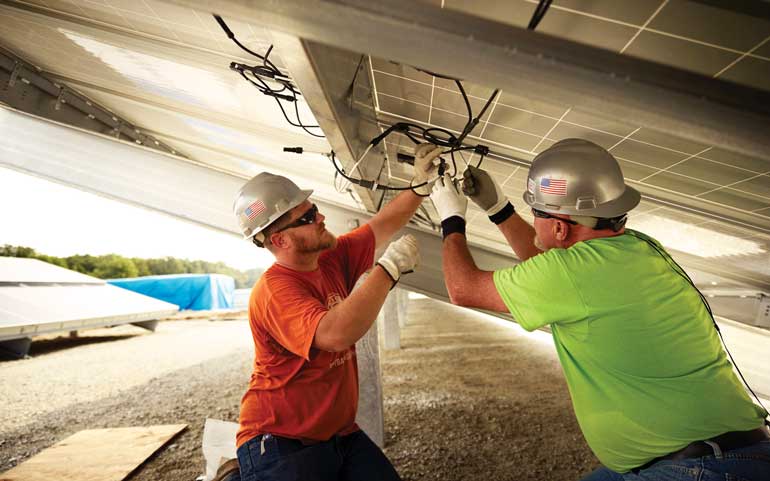When a $4.5 billion-a-year employee-owned solar EPC determined how to best maximize local trainee headcounts on projects, the solution not only made strong economic sense but also presented an unusual competitive edge. Indeed, McCarthy Building, based in St. Louis, has constructed a reputation of having one of the best worker training programs in U.S. solar.
Company-wide, McCarthy has about 150 full-time solar workers, and has been ranked the 7th largest solar EPC in the country.
Part of the inspiration for maximizing local trainees is political. Solar RFPs often contain requirements for a contractor to make local hires or to train local workers. If several bidders make similar offers in terms of cost, the offer of a high level of worker training can swing a selection committee.
McCarthy uses about 9 million man-hours of labor per year, and that number rises to 30 million if sub-contractor trades are included, reckons Scott Canada, the SVP of renewable energy for the company, located in Phoenix. On average, a solar project in a newer geographic market may include 1 million man-hours, with a mix of 30 percent staff and 70 percent local workers, of which many are trainees, he calculates.
Some solar EPCs use an inversion of McCarthy’s ratio, employing 70 percent staff and using only 30 percent local trainees. Much of the determination of which ratio fits the job is how fast the project is going up, whether the site is in a mature solar market and how far the job is from headquarters or a branch office.
Using a high percentage of local workers in areas like the Southeast, where rainfall is frequent, saves McCarthy on hotel bills, travel costs and incentive pay for traveling, Canada notes.
“For a new job, we will bring in a small, well-trained crew, and the starting point normally is the local chamber of commerce and employment office,” Canada explains. “We coordinate with them, and they help us engage with job fairs and to reach out to training offices operated by the local economic development office.”
In the wrong hands, using this many inexperienced workers could lead to all sorts of issues, but McCarthy has embedded a tried and true training method into its core principles that’s turned this potential shortcoming into a strength.
Training Day
McCarthy employs Training Within Industry (TWI) methods to train its workforce, which focus on helping supervisors in their support and instruction techniques to improve daily work methods. The TWI Institute, based in Liverpool, N.Y., was formed in 2002 and is now a global organization offering its training methodology in over 18 languages.
“We practice the guidelines of the TWI, try to funnel trainees into union programs and we do labor tracking for all our workers,” Canada says. “We definitely will hire workers back on another job.”
TWI instruction modules are tailored to specific industries, like solar. The most basic module TWI offers is Job Instruction training, which teaches a method for instructing an operator how to perform a job correctly, safely and conscientiously.
While most job processes are performed by various workers using different methods, Job Instruction training requires trainers and workers to identify the “one best way,” TWI says. By teaching the process one way, which can be an evolving refinement, a standard method is created across operators and shifts. Additional benefits of the Job Instruction methodology are reduced training time, less scrap and rework plus increased job satisfaction.
Another module of the TWI process is Job Methods Training, which builds on the skills of the operators and first line leaders including team leaders, supervisors and group leaders. The aim of the module is to produce greater quantities of quality products in less time by making the best use of the people, machines and materials currently available. Participants are taught how to break down jobs into their constituent operations. Every detail is questioned in a systematic manner to generate ideas for improvement. New methods are developed by eliminating, combining, rearranging and simplifying steps in the process.
TWI modules also include Job Instruction Follow-up, Job Safety, Job Relations, Union Job Relations and Problem Solving.
While trainees can help keep wage costs down, their TWI education also helps produce a better-quality product, improves labor efficiency and improves safety, Canada enumerates.

Holistic installation
Given McCarthy’s sensitivity to its worker environment, it is not surprising that the company has a thoughtful approach to its treatment of the actual environment.
As a top 20 green builder in the country, with $7.6 billion worth of green construction projects complete, McCarthy takes its “Leaving Green Footprints” mission statement seriously, weaving sustainability throughout its end-to-end process by:
- Encouraging every client and building partner to seriously consider sustainable building practices
- Bringing viable green building solutions to the table; and
- Educating employees to give them the tools to lead the way on the jobsite
McCarthy helps clients achieve sustainability goals through design assistance in energy efficiency and net-zero energy systems as well as in water conservation and wastewater management, Canada notes.

Green leadership impacts a project in a variety of ways. One impact is stewardship in the chain of ownership of materials that might be a requirement of LEED certification for the project. Another is in energy efficiency, which might include the use of LEDs for temporary lighting even if the upfront costs are more expensive than standard lighting, since a return on the investment can be spread over several jobs. In the case of a solar project, McCarthy will aim at early operation so that solar energy can be used to power continuing site operations.
Water conservancy is another jobsite practice that can help limit consumption at a site, which is paramount in desert locations. Similarly, wastewater control can avoid construction debris runoff into community storm water networks or worse, into fresh water systems.
Using sustainable design and construction practices, McCarthy has developed a strategy for reducing waste during the installation. Through Simple Set Up Solutions, an Atlanta-based firm that connects recyclers and local vendors to find end-use buyers for construction site waste, McCarthy formed a unique partnership with recycler JWC Environmental whereby construction waste is being recycled into roofing felt and other building materials while eliminating landfill expenses. As an example, construction of its three Meridian projects in Mississippi, over 80 MW total, will be at least 98 percent sustainable because of this program. The recovery of reusable materials can help reduce cost at the next project.
McCarthy brings its sustainability practices to every job, which now includes over 1.7 GW of installed solar and another 300 MW of battery storage. The company has built close to a dozen solar plants of 50 MW or more, close to two dozen solar plants between 10 MW and 50 MW, and various smaller projects.
“We’re not just a ‘sustainable building company,’” Canada says. “We’re commercial builders whose commitment to environmental responsibility is ingrained in the way we think, from the design phase through post-construction.”
Charles W. Thurston is a freelance writer covering solar energy from Northern California.
— Solar Builder magazine

Leave a Reply
You must be logged in to post a comment.